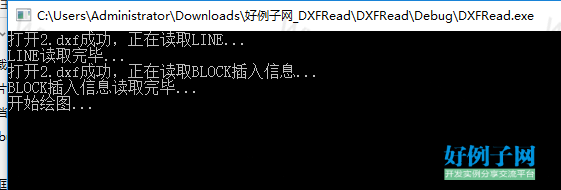实例介绍
【实例简介】新手或者入行的值得看看
【实例截图】

#define _CRT_SECURE_NO_WARNINGS //防止新编译器老函数使用报错
#include "DXFRead.h"
using namespace std;
IMPLEMENT_DYNCREATE(LINEPoint, CObject)
IMPLEMENT_DYNCREATE(BLOCKPoint, CObject)
#define FILENAME "2.dxf"
#define SAVENAME "2.png"
LINEPoint::LINEPoint(CADLINE &line)
{
m_line = line;
}
BLOCKPoint::BLOCKPoint(CADBLOCK &block)
{
m_block = block;
}
void DXFRead::ReadLine(CADDATA &data)
{
FILE *fp = fopen(FILENAME, "r");
if (!fp)
{
cout << "读取" << FILENAME << "失败,任意键退出" << endl;
getchar();
exit(0);
}
else
{
cout << "打开" << FILENAME << "成功,正在读取LINE..." << endl;
}
while (!feof(fp) && !ferror(fp))
{
fscanf(fp, "%s", &str);
//扫描块中线
if (strcmp(str, "BLOCK") == 0)
{
fscanf(fp, "%s", &str);
while (strcmp(str, "2") != 0)
{
fscanf(fp, "%s", &str);
}
//获得块名字
fscanf(fp, "%s", &name);
//如果不是这两个块,做记录
if (strcmp(name,"$MODEL_SPACE") != 0
&& strcmp(name, "$PAPER_SPACE") != 0)
{
while (strcmp(str, "ENDBLK") != 0)
{
fscanf(fp, "%s", &str);
//扫描块中线
if (strcmp(str, "LINE") == 0)
{
//归属块
strcpy(tempLine.name, name);
//x1
while (strcmp(str, "10") != 0)
{
fscanf(fp, "%s", &str);
}
fscanf(fp, "%s", &str);
tempLine.x1 = atof(str);
//y1
while (strcmp(str, "20") != 0)
{
fscanf(fp, "%s", &str);
}
fscanf(fp, "%s", &str);
tempLine.y1 = atof(str);
//z1
while (strcmp(str, "30") != 0)
{
fscanf(fp, "%s", &str);
}
fscanf(fp, "%s", &str);
tempLine.z1 = atof(str);
//x2
while (strcmp(str, "11") != 0)
{
fscanf(fp, "%s", &str);
}
fscanf(fp, "%s", &str);
tempLine.x2 = atof(str);
//y2
while (strcmp(str, "21") != 0)
{
fscanf(fp, "%s", &str);
}
fscanf(fp, "%s", &str);
tempLine.y2 = atof(str);
//z2
while (strcmp(str, "31") != 0)
{
fscanf(fp, "%s", &str);
}
fscanf(fp, "%s", &str);
tempLine.z2 = atof(str);
data.LINE.Add(new LINEPoint(tempLine));
}
}
}
}
//扫描主坐标系线
else if (strcmp(str, "LINE") == 0)
{
//归属块
strcpy(tempLine.name, "ReferenceBlock");
//x1
while (strcmp(str, "10") != 0)
{
fscanf(fp, "%s", &str);
}
fscanf(fp, "%s", &str);
tempLine.x1 = atof(str);
//y1
while (strcmp(str, "20") != 0)
{
fscanf(fp, "%s", &str);
}
fscanf(fp, "%s", &str);
tempLine.y1 = atof(str);
//z1
while (strcmp(str, "30") != 0)
{
fscanf(fp, "%s", &str);
}
fscanf(fp, "%s", &str);
tempLine.z1 = atof(str);
//x2
while (strcmp(str, "11") != 0)
{
fscanf(fp, "%s", &str);
}
fscanf(fp, "%s", &str);
tempLine.x2 = atof(str);
//y2
while (strcmp(str, "21") != 0)
{
fscanf(fp, "%s", &str);
}
fscanf(fp, "%s", &str);
tempLine.y2 = atof(str);
//z2
while (strcmp(str, "31") != 0)
{
fscanf(fp, "%s", &str);
}
fscanf(fp, "%s", &str);
tempLine.z2 = atof(str);
data.LINE.Add(new LINEPoint(tempLine));
}
}
cout << "LINE读取完毕..." << endl;
fclose(fp);
}
void DXFRead::ReadInsert(CADDATA &data)
{
FILE *fp = fopen(FILENAME, "r");
fp = fopen(FILENAME, "r");
if (!fp)
{
cout << "读取" << FILENAME << "失败,任意键退出" << endl;
getchar();
exit(0);
}
else
{
cout << "打开" << FILENAME << "成功,正在读取BLOCK插入信息..." << endl;
}
while (!feof(fp) && !ferror(fp))
{
fscanf(fp, "%s", &str);
if (strcmp(str, "INSERT") == 0)
{
//读取插入块名字
while (strcmp(str, "2") != 0)
{
fscanf(fp, "%s", &str);
}
fscanf(fp, "%s", &str);
strcpy(tempBlock.name, str);
//基点坐标
//rx
while (strcmp(str, "10") != 0)
{
fscanf(fp, "%s", &str);
}
fscanf(fp, "%s", &str);
tempBlock.rx = atof(str);
//ry
while (strcmp(str, "20") != 0)
{
fscanf(fp, "%s", &str);
}
fscanf(fp, "%s", &str);
tempBlock.ry = atof(str);
//rz
while (strcmp(str, "30") != 0)
{
fscanf(fp, "%s", &str);
}
fscanf(fp, "%s", &str);
tempBlock.rz = atof(str);
//读取比例因子
//cx
while (strcmp(str, "41") != 0)
{
fscanf(fp, "%s", &str);
}
fscanf(fp, "%s", &str);
tempBlock.cx = atof(str);
//cy
while (strcmp(str, "42") != 0)
{
fscanf(fp, "%s", &str);
}
fscanf(fp, "%s", &str);
tempBlock.cy = atof(str);
//cz
while (strcmp(str, "43") != 0)
{
fscanf(fp, "%s", &str);
}
fscanf(fp, "%s", &str);
tempBlock.cz = atof(str);
data.BLOCK.Add(new BLOCKPoint(tempBlock));
}
}
cout << "BLOCK插入信息读取完毕..." << endl;
fclose(fp);
}
void DXFRead::DrawImage(CADDATA &data)
{
LINEPoint *linep = NULL;
BLOCKPoint *blockp = NULL;
uchar* Img = NULL;
cout << "开始绘图..." << endl;
//创建图像,深度为8,3通道RGB图像
cvImg = cvCreateImage(cvSize(15000, 15000), 8, 3);
Img = (uchar *)cvImg->imageData;
int step = cvImg->widthStep / sizeof(uchar);
int channels = cvImg->nChannels;
//清空图像
for (int i = 0; i<cvImg->height; i )
for (int j = 0; j<cvImg->width; j ) {
Img[i*step j*channels 0] = 0;
Img[i*step j*channels 1] = 0;
Img[i*step j*channels 2] = 0;
}
for (int i = 0; i < data.LINE.GetCount(); i )
{
linep = (LINEPoint*)data.LINE.GetAt(i);
//如果是正常线
if (strcmp(linep->m_line.name, "ReferenceBlock") == 0 )
{
cvLine(cvImg,
cvPoint(20 * ((linep->m_line.x1) 300), 20 * ((linep->m_line.y1) 300)),
cvPoint(20 * ((linep->m_line.x2) 300), 20 * ((linep->m_line.y2) 300)),
CV_RGB(0, 255, 0), 4);
}
else
{
for (int j = 0; j < data.BLOCK.GetCount(); j )
{
//获取线归属块信息
blockp = (BLOCKPoint*)data.BLOCK.GetAt(j);
if (strcmp(linep->m_line.name, blockp->m_block.name) == 0)
{
cvLine(cvImg,
cvPoint(20 * ( (blockp->m_block.cx) *(linep->m_line.x1) blockp->m_block.rx 300), 20 * ((blockp->m_block.cy) *(linep->m_line.y1) blockp->m_block.ry 300 ) ),
cvPoint(20 * ((blockp->m_block.cx) *(linep->m_line.x2) blockp->m_block.rx 300), 20 * ( (blockp->m_block.cy) *(linep->m_line.y2) blockp->m_block.ry 300 ) ),
CV_RGB(0, 255, 0), 4);
}
}
}
}
cvSaveImage(SAVENAME, cvImg);
//释放图像所占的内存
cvReleaseImage(&cvImg);
}
int main()
{
CADDATA cadData;
DXFRead readData;
readData.ReadLine(cadData);
readData.ReadInsert(cadData);
readData.DrawImage(cadData);
return 0;
}
好例子网口号:伸出你的我的手 — 分享!
小贴士
感谢您为本站写下的评论,您的评论对其它用户来说具有重要的参考价值,所以请认真填写。
- 类似“顶”、“沙发”之类没有营养的文字,对勤劳贡献的楼主来说是令人沮丧的反馈信息。
- 相信您也不想看到一排文字/表情墙,所以请不要反馈意义不大的重复字符,也请尽量不要纯表情的回复。
- 提问之前请再仔细看一遍楼主的说明,或许是您遗漏了。
- 请勿到处挖坑绊人、招贴广告。既占空间让人厌烦,又没人会搭理,于人于己都无利。
关于好例子网
本站旨在为广大IT学习爱好者提供一个非营利性互相学习交流分享平台。本站所有资源都可以被免费获取学习研究。本站资源来自网友分享,对搜索内容的合法性不具有预见性、识别性、控制性,仅供学习研究,请务必在下载后24小时内给予删除,不得用于其他任何用途,否则后果自负。基于互联网的特殊性,平台无法对用户传输的作品、信息、内容的权属或合法性、安全性、合规性、真实性、科学性、完整权、有效性等进行实质审查;无论平台是否已进行审查,用户均应自行承担因其传输的作品、信息、内容而可能或已经产生的侵权或权属纠纷等法律责任。本站所有资源不代表本站的观点或立场,基于网友分享,根据中国法律《信息网络传播权保护条例》第二十二与二十三条之规定,若资源存在侵权或相关问题请联系本站客服人员,点此联系我们。关于更多版权及免责申明参见 版权及免责申明



网友评论
我要评论